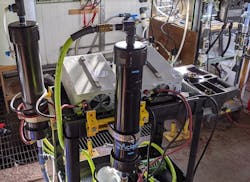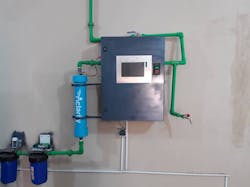Electrochemical Disinfection Primer
Julie Bliss Mullen is CEO of Aclarity Water. Bliss Mullen can be reached at [email protected].
undefinedDisinfection is a complicated affair. Solutions often require chlorine addition, changing out ultraviolet (UV) bulbs, handling the creation of ozone or chlorine dioxide and dealing with biofilms. Further, each solution leaves some common pathogens untreated, leading to complex treatment trains with the cost and operational hurdles adding up.
That said, electrochemical solutions have been found to be an affordable alternative with few maintenance shortcomings and strong pathogen removal. It also breaks carbon-fluorine bonds in PFAS, mineralizes toxic solvents and pharmaceuticals, eliminates ammonia straight to nitrogen gas, and even eradicates poisons, such as cyanide, all in one treatment step.
This likely sounds too good to be true, and the industry is rightly skeptical of over-blown claims from new treatment technologies. Accordingly, the purpose of this article will describe the technology and present the emerging evidence of its efficacy in several applications to distinguish and demonstrate its results and potential. Electrochemistry offers a newfound opportunity for the water treatment industry to address long-standing treatment issues.
Understanding Electrochemical Treatment
One solution is Aclarity’s electrochemical system (AES). This system disinfects microbes and mineralizes organic and recalcitrant compounds without the addition of chemicals. By using electricity and naturally occurring salts in the water, chlorine- and oxygen-based mixed oxidants are produced on or near the electrode surface. At low voltages, around 6 volts, oxidants, such as hypochlorite and hydrogen peroxide are generated.
As the voltage increases, ozone, chlorine dioxide, and hydroxyl radicals are formed. Increase voltage more, between 10V and 15V, and superoxide ions and free electrons are generated right on the anode surface. The mix of these oxidants provides disinfection and treatment effectiveness with low power, making it a promising water treatment technology.
Scale & Size
Electrochemistry is amenable in small and large sizes. Modular reactors are stacked in parallel and water is fed in open-loop with a recirculating holding tank to handle up to 1 million gallon per day (mgd) flow rates. The number of reactors in the system is dependent on the recalcitrance and complexity of the water matrix. The electrodes are made of inexpensive metal oxide and are either porous or solid, depending on the influent water quality and contaminants of concern for each project.
The in-situ oxidants are generated from salts in the water. With higher conductivity, the AES will draw more amperage and take less time and anode surface area to degrade compounds. The AES is applicable in many industries and performs best in applications with concentrated compounds as most reactions are first-order.
Industrial Wastewater Disinfection
Disinfection of industrial wastewater is a growing concern, especially with increasing zero-liquid discharge policies and growing surcharges from municipal sewer systems. Disinfection is critical in cooling tower, food processing, pharmaceutical, chemical and recreational applications, among others.
Chemical use in industrial wastewater disinfection is the norm, but safety, storage, footprint and long-term costs are major issues. Emerging and existing in-situ disinfection systems, such as Miox, produce chlorine in a brine and are good at disinfecting certain pathogens but do not inactivate resistant pathogens such as Cryptosporidium. Even Legionella can survive chlorine in biofilms of hot tubs, pools and water playgrounds. The composition of industrial wastewater varies significantly application to application, but chemical oxygen demand is commonly quantified as a surrogate of industrial wastewater quality, which can range from a couple parts per million to tens of thousands of parts per million.
AES has disinfected various industrial wastewaters from dairy waste to landfill leachate while simultaneously degrading other contaminants of concern such as ammonia, alcohols, ethers and VOCs. Since the electrochemical process does not require chemical addition, its safety, footprint and lifetime costs are reduced. The system has a simple on and off switch that can also be operated remotely to decrease labor costs, and simple backwashing or polarity reversal is the only form of maintenance necessary.
The costs to disinfect while also destroying contaminants of concern are significantly less than competing processes, which typically involve a combination of membrane bioreactor (MBR), reverse osmosis (RO), activated carbon and chlorine. In the case of landfill leachate, the electrochemical system is able to destroy PFAS, ammonia and microbes in one step for a competitive cost.
Domestic Wastewater Treatment
Domestic wastewater is ridden with enteric bacteria, viruses and protozoan cysts. Improperly disinfected wastewater can have a detrimental effect on rivers and community water sources, causing concern for the health and safety of the public and wildlife. To prevent the spread of waterborne diseases from wastewater, disinfectants, chlorine and UV are most commonly used. However, suspended solids absorb UV radiation and decrease disinfection performance from chlorine. Other main concerns in wastewater are nitrogen, phosphorus, BOD and COD, which are not conventionally removed by disinfectants.
Even with high suspended solids found in domestic wastewater, the system disinfects bacteria, viruses and cysts to greater than 99.99996% (>6.3 log) removal in a single pass. The AES was evaluated in a challenge test at a third-party laboratory for disinfection to NSF/ANSI P231 standards. The challenge test had high turbidity of 30.7 NTU, pH of 8.9, and hardness of 136 ppm. With one reactor processing 10 gallons per minute and power of 6.7V and 8.0A, the AES was still able to disinfect bacteria and viruses to greater than 6.3 log removal.
While disinfecting, the electrochemical system simultaneously converts ammonia and TKN straight to nitrogen gas and decreases BOD, as measured in primary and secondary wastewater. This multi-purpose treatment process has the potential to transform in municipal and decentralized septic systems to a simple automated removal process able to handle flows in the million gallon per day range.
Drinking Water Applications
Throughout the world, and especially in the developing world, people are supplied by polluted water sources. Often, due to substandard or non-existent infrastructure, the water supply for homes or communities is polluted with pathogens, including viruses (like Norovirus or Hepatitis), bacteria (including E. coli and Legionella) and even protozoan cysts (such as Giardia lamblia and Cryptosporidium parvum).
While large municipal drinking water systems are designed to remove these organisms, smaller local systems, those located toward the end of the distribution system, and homes with private wells are often ill-equipped to deal with these problems. Trace contaminants of emerging concern (CECs) are another growing concern in drinking water and often present a challenge for operators and caregivers.
Looking for a treatment system that required little maintenance, could be remotely operated, had a short return on investment, and was effective in cleaning groundwater while maintaining an acceptable taste profile, Untapped (dloHaiti) partnered with Aclarity to provide a drinking water solution for the city of Bamako, Mali.
Together with the community, Untapped dug a well, built a community water treatment building and installed the AES in the summer of 2019. At a small capacity of 10 gallons per minute and only 40 watts of power, water treated by the system passed physical and microbiological testing at a national lab where complete inactivation of pathogens was achieved with just 210 µS/cm conductivity, rendering the water safe for consumption.
The resultant drinking water was tuned to achieve a desired chlorine residual of 0.5 mg/L. A disinfection byproduct study was conducted with various water sources and the disinfection by-products formed over time were well below the U.S. EPA regulatory limit.
Operating at higher voltages, the electrochemical disinfection system has shown it can disinfect while mineralizing PFAS and other CECs in groundwater. Using 0.053 kWh of electricity per gallon of water, it can disinfect to greater than 6.3 log removal and mineralize total PFAS compounds from 50 to 5 ppt.
Electrochemical disinfection technology produces a slurry of advanced oxidants for the disinfection of microbes and simultaneous destruction of various contaminants including, but not limited to, PFAS, VOCs, nitrogen and cyanide.

